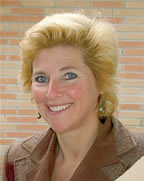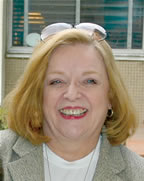Breastfeeding Benefits
Creative marketing project uses a telenovela to battle childhood obesity
May 1, 2007
By Valerie Orleans
Childhood obesity has become a serious health problem in America, particularly in Latino communities where overfeeding children often starts in infancy. That’s why many healthcare agencies are encouraging Latina mothers to breastfeed their children.
“The problem is that Hispanic mothers — like many others — consider big babies to be healthy babies,” said Shari McMahan, professor and chair of health science and director of Cal State Fullerton’s Center for the Promotion of Healthy Lifestyles and Obesity Prevention. “By overfeeding their babies, they may start lifetime habits of overeating that cause both childhood and later-life obesity.”
McMahan, who garnered a grant from the Centers for Disease Control, and Gail Love, assistant professor of communications, have teamed up to inform Latina mothers about the benefits of breastfeeding.
Love, who has more than 25 years of experience in TV, advertising and marketing (10 of which were in healthcare marketing) before she began teaching at CSUF six years ago, understands how to craft and communicate persuasive messages to different audiences. Together with McMahan, the pair created a 10-minute film, written and produced as a telenovela (Spanish for soap opera), showing Latinas talking about how good breastfeeding is for babies.
The Spanish-language film also dispels the myths of breastfeeding. It is being provided to physicians’ offices, family health clinics and other agencies in an effort to reach Latina mothers.
The project is one example of how communications and health care can provide a community service.
Beginning next year, CSUF students also can benefit. Love will teach a new course, focusing strictly on health communications campaigns. A joint offering between the College of Communications and the College of Health and Human Development, the class will introduce graduate students to a wide range of strategic communication strategies, developed to give people the information they need to stay healthy.
“The College of Communications has always taught courses on persuasive communications but I was interested in applying the same persuasive strategies that marketers and advertisers use to motivate people to adopt healthy behaviors,” said Love, who developed the class.
“This concept is called ‘social marketing’ wherein we use traditional marketing strategies and tactics to address social issues. As our population ages and we face challenges such as the childhood obesity problem, I want to use my experience in the healthcare marketing field to show students how a well-planned, well-executed program can make a difference in people’s lives.
“Communicating with diverse populations requires messages that are culturally sensitive,” she said. “It’s not enough to simply translate existing information. You have to tailor the message to the audience.”
That explains the telenovela approach used in the breastfeeding video.
“Research indicates that telenovelas have a very high viewership among women,” Love said. “We used a communication strategy called ‘Entertainment-Education,’ where educational information is presented in an entertainment format. The strategy has been successful in numerous mass-media campaigns in developing countries, particularly in Latin America. We want to harness that power by offering viewers important educational messages embedded in a familiar, culturally-sensitive format that will not be boring or sound like a lecture.”
It’s not enough to just provide the information, she added. “You have to deliver it so that your intended audience will pay attention. That means being more creative and developing memorable images to which your audience can relate.”
Students will be able to receive course credit in either communications or health science/public health.
“We live in an information age where communication can shape attitudes and change behaviors,” Love said. “By offering a choice of course credit in two colleges, it gives us a multi-disciplinary approach that combines the power of two fields of study. The students will see how very closely connected health science and communication truly are.”


